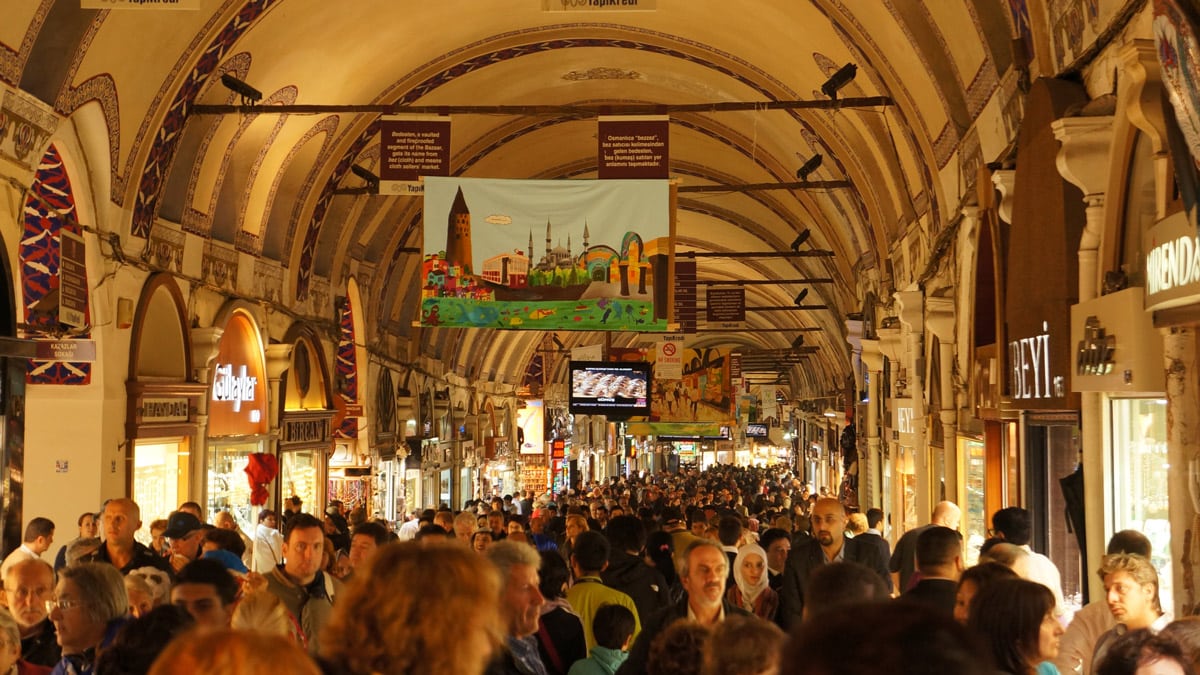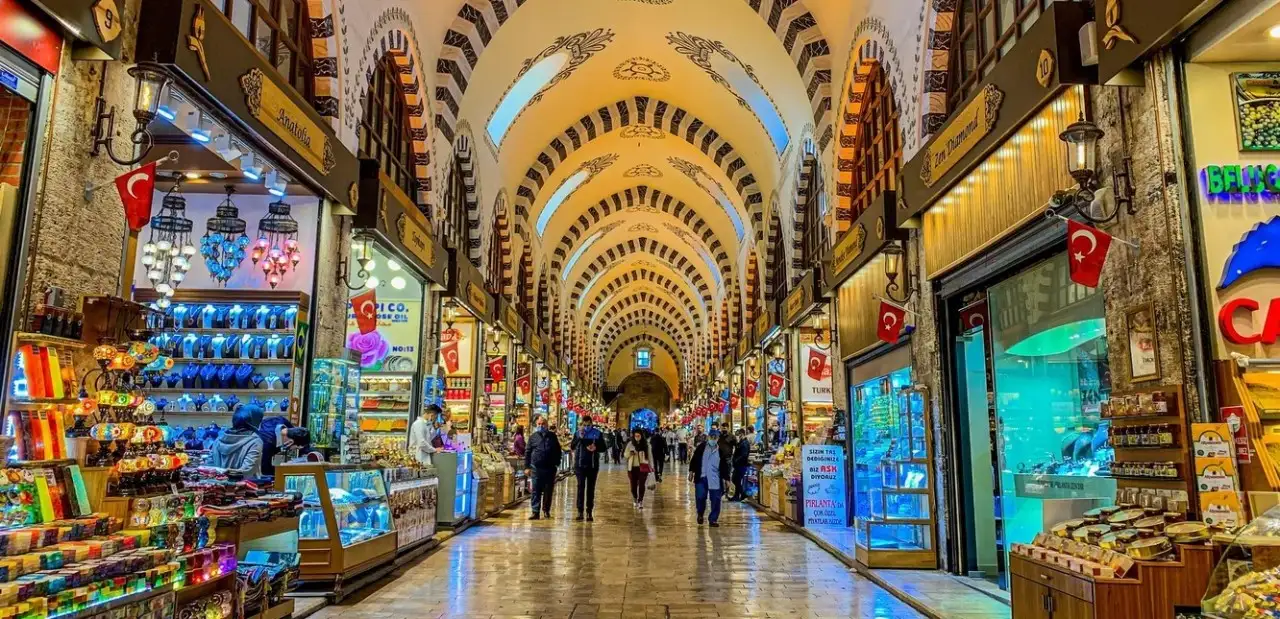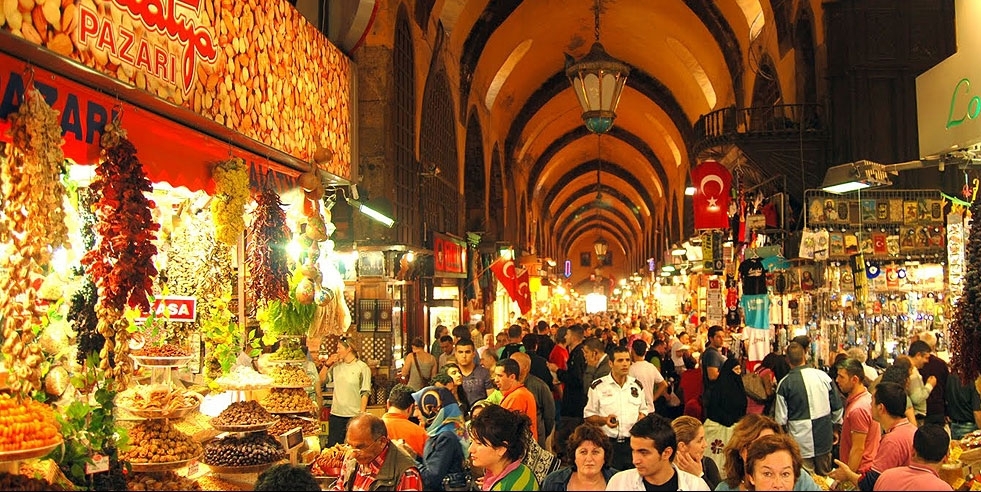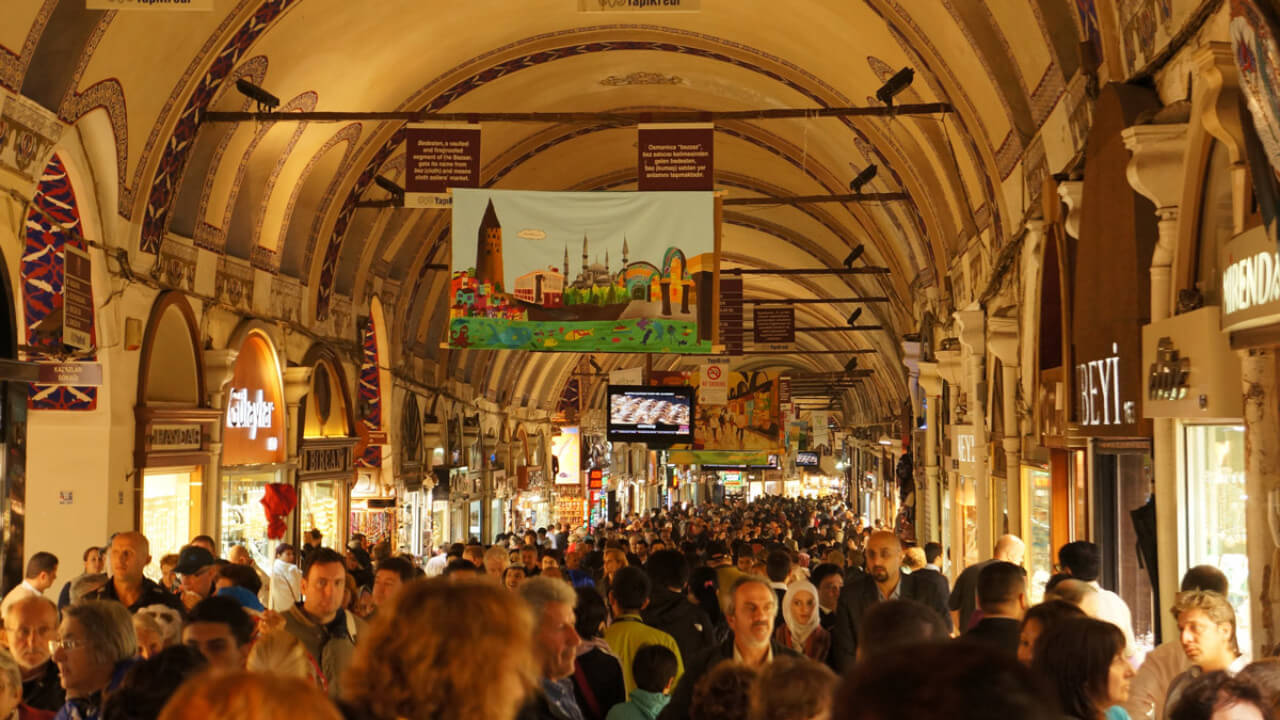In the heart of Istanbul, two legendary worlds where history and trade have intertwined for centuries await you: the Grand Bazaar and the Spice Bazaar. But where to begin? Are you afraid of getting lost in the seemingly endless corridors of the Grand Bazaar, or do you not know what to choose amidst the dizzying aromas of the Spice Bazaar? Don't worry, this guide will be your compass. We will take you on a journey that not only leads you past the storefronts but also allows you to feel the soul of these historic labyrinths. From the most special stops on the list of things to do in the Grand Bazaar to the subtleties of the art of bargaining, and from hidden courtyards where you can take a break with a cup of tea away from the crowds, we will take every step together. Fasten your seatbelts, because we are embarking on an unforgettable journey through time and taste!
Get Lost in the 4,000-Shop Labyrinth of the Grand Bazaar

The Grand Bazaar is much more than a shopping center; it is a living, breathing city with its own rules, traditions, and rhythm. This is one of the oldest and largest covered markets in the world, founded by Sultan Mehmed the Conqueror in 1461, just a few years after he conquered Istanbul, to provide income for Hagia Sophia. This structure, which seems complex at first glance, is actually a perfect example of an economic and social ecosystem that has stood for centuries.
The First Shopping Mall in History: The Birth of an Empire
The heart of the bazaar is the Cevahir and Sandal Bedestens, where antiques and valuables are still sold today. These two structures are considered the inner fortresses of the bazaar and served as high-security vaults where the wealthiest merchants of the Ottoman Empire stored their capital, jewelry, and guild records. This was one of the most important trade centers in the world, where goods from all corners of the empire converged.
Initially made of wood, the structure has survived countless fires and earthquakes throughout its history. However, after every disaster, just like Istanbul itself, it has risen from its ashes even stronger. Therefore, the stone paths you walk on today tell the story not only of a shopping place but also of a city's resilience and its power to constantly renew itself. The Grand Bazaar is not a static museum; it is a living organism that has been operating continuously for 560 years.
The Art of Navigating the Labyrinth and What to Buy
With 61 streets, approximately 4,000 shops, and 22 gates, getting lost in the Grand Bazaar is part of the experience. So don't panic; on the contrary, enjoy this labyrinth. Still, if you need a starting point, you can use the bazaar's main artery, Kalpakçılar Street. This street connects the two most used gates, Beyazıt and Nuruosmaniye, and serves as a kind of backbone for you.
So, what should you buy from this treasure chest?
Antiques and Valuables: The Cevahir and Sandal Bedestens are a paradise for those who want to travel back in time, with everything from silver sets and old watches to Ottoman medals and antique objects.
Handwoven Carpets and Kilims: Handwoven carpets and kilims, colored with natural dyes and carrying the stories of Anatolia in every knot, are among the most valuable products of the bazaar.
Leather Goods: You can find high-quality leather jackets, bags, and shoes made by master artisans.
Iznik Tiles and Ceramics: Iznik tiles, bowls, and plates, which are eye-catching with their vibrant colors and craftsmanship, are a great option to add a touch of Ottoman palaces to your home.
Jewelry and Silver: The Grand Bazaar is famous for its jewelers, who have a say in the world gold market. You will surely find a piece that suits your taste among thousands of jewelry items that combine traditional and modern designs.
The Grand Bazaar is located right in the heart of the historical peninsula. You can crown your visit here by exploring the magnificent https://www.yerelrehber.com/en/city/istanbul, which is just a few steps away.
The Art of Bargaining: More Than Just a Purchase
The most important unwritten rule of shopping in the Grand Bazaar is bargaining. But don't see it as a price war; bargaining here is a form of communication, a social ritual. The Ahilik tradition, which the shopkeepers have maintained for generations, is based on trust and respect; so much so that people once entrusted their money to the shopkeepers they trusted instead of a bank.
You can participate in this enjoyable tradition by following a few simple steps:
Always smile and be polite. This is the beginning of a conversation.
The first price the seller gives is an invitation. Indicate that you like the product, but don't accept it immediately.
Set a price in your mind that you think is fair for the product. The most common method is to start with an offer slightly lower than the initial price and meet in the middle.
If you can't agree on a price, don't hesitate to say thank you and leave the shop. It is highly likely that you will find the same or a similar product in another shop.
Remember, the goal is not just to get a lower price, but also to be a part of this centuries-old culture.
Breathe in the Scents of Spices and Turkish Delight at the Spice Bazaar

When you leave the magnificent chaos of the Grand Bazaar and walk towards Eminönü, the intense and dizzying scents that fill your nose draw you into another world. This is the Spice Bazaar, Istanbul's temple of flavor. While the Grand Bazaar showcases the breadth of an empire's craft and trade, the Spice Bazaar presents the richness and depth of the exotic Spice Road coming from the East.
The Last Stop on the Spice Road in Istanbul
This bazaar, built in the 1660s by Turhan Sultan to cover the expenses of the adjacent New Mosque Complex, is one of Istanbul's oldest covered markets. Although it was initially called the New Bazaar or Valide Bazaar, it became famous among the public as the Spice Bazaar because its construction was financed with taxes from Egypt and the shops predominantly sold spices and goods coming through Egypt.
Even before you enter, the scents of cinnamon, cumin, saffron, and freshly ground Turkish coffee greet you. This is not a shopping center, but a library of flavors and scents. Each stall is like a colorful treasure from different corners of the world.
Mouth-Watering Delicacies: What to Buy and What to Taste?
Get ready to go on a flavor hunt at the Spice Bazaar, guided by your senses. Here's what you should add to your list:
Spices: Don't just stick to the spices you know. Be sure to ask for sumac, which will add a unique taste to your salads, red pepper flakes for a spicy touch to your dishes, and of course, saffron, the king of spices. Remember that real saffron consists of red threads and has a distinctive strong aroma; it adds a golden color and a unique flavor to many dishes, from pilaf to desserts.
Turkish Delight and Sweets: You can find the freshest and most diverse Turkish delights in the world here. Double-roasted pistachio, rose, mint, clotted cream... The options are endless. Also, stalls with pestil (fruit leather) made from mulberry or grape, cevizli sucuk (walnut sausage), and baklava with its many layers of flavor await you.
Nuts and Dried Fruits: Bright green pistachios, giant walnuts, sun-dried apricots, and honeyed figs are both healthy and delicious snacks.
Herbal Teas and Turkish Coffee: You can buy rose, jasmine, pomegranate, and apple teas sold in colorful mounds, or return home with fragrant, freshly ground Turkish coffee. Remember, the first coffeehouses in Istanbul were opened in this area, and coffee was once as important a trade commodity as spices.
Insider Tip: Don't be shy! Shopkeepers are usually happy to let you taste their products. Tasting a piece of Turkish delight or a few pistachios is the most enjoyable way to make the right choice.
The rare spices and Turkish delights you'll buy from the Spice Bazaar were the flavors that once adorned the tables of Ottoman sultans. To feel the imperial splendor behind these tastes more closely, you might consider visiting the nearby https://www.yerelrehber.com/en/explore/things-to-do/topkapi-palace.

Take a Tea Break in the Historic Hans Inside the Bazaar
When you get tired of the crowded and bustling main streets of the Grand Bazaar, take refuge in the places where the real magic is hidden: the historic hans. These hans are calm and peaceful oases in the middle of the bazaar's noisy chaos. Discovering them will show you that the bazaar is not just a showcase, but a living workshop where hundreds of artisans produce their goods.
What is a Han? The Secret Courtyards of the Grand Bazaar
Historically, hans (caravanserais) were structures with courtyards where merchants and caravans from distant lands would spend the night, safely store their goods, and conduct trade. Today, these hans have lost their accommodation function and have been replaced by the workshops of the masters who produce the magnificent products sold in the bazaar. Silversmiths, jewelers, carpet repairers, coppersmiths... They all continue to keep centuries-old traditions alive within these historic walls. Stepping into a han is like moving from the bazaar's showcase to its kitchen.
A Journey Through Time: Zincirli Han and Others
Although there are 23 hans waiting to be discovered in the Grand Bazaar , some will leave you in awe.
Zincirli Han: Undoubtedly the most beautiful and most photographed han in the bazaar. With its red facade, dark green shutters, cobblestone courtyard, and the tree in the middle, it resembles a film set. The sounds of hammers coming from the jewelry workshops inside are proof of how vibrant this historic place still is. Don't forget to visit the carpet shop of Şişko Osman, one of the han's oldest residents.
Çuhacı Han: This is the center of gold manufacturing. The most famous story about the han is that the gold dust accumulated in the pipes of the fountain where jewelers washed their hands revealed kilograms of gold years later. Even this legend shows what great wealth has passed through these walls.
Kalcılar Han: This is the right address to witness the journey of silver. In the small workshops lined up on both sides, you can see how silver is processed, polished, and turned into a work of art.
Cebeci Han: This han, which used to accommodate merchants, now hosts shops selling maritime supplies, offering an interesting example of how the bazaar adapts to changing needs.
A Break with a Taste of History: Şark Kahvesi
After visiting the hans and witnessing the magical world of the artisans, the best place to relieve your fatigue is Şark Kahvesi, one of the authentic stops inside the bazaar. With its traditional decoration, Turkish coffee brewed in copper pots, and strong tea, this is the perfect resting spot that will take you away from the speed of the modern world and leave you to the slow rhythm of history. Sit down, sip your coffee, and enjoy the centuries-old atmosphere around you.
While You're Here: Treasures Beyond the Bazaars
If you still have energy after exploring the Grand Bazaar and the Spice Bazaar, don't miss the other treasures right next to this historic area. This trip will turn your shopping experience into an unforgettable cultural tour.
Süleymaniye Mosque: When you climb a short slope from the Grand Bazaar, you will be greeted by the Süleymaniye Mosque, the monument of the peak period of the Ottoman Empire, which Mimar Sinan called his journeyman's work. Not just a place of worship, but a massive complex with its madrasas, library, and hammam, this structure offers one of the most beautiful silhouettes of Istanbul. It will fascinate you with its view overlooking the Golden Horn and the Bosphorus, its peaceful courtyard, and its incredible acoustics that showcase Sinan's engineering genius.
Rüstem Pasha Mosque: When you step away from the crowds of the Spice Bazaar and enter a narrow street, a work of art that looks quite modest from the outside awaits you: the Rüstem Pasha Mosque. This mosque is a hidden paradise for art lovers. When you step inside, you will see that the walls are covered from floor to dome with the most beautiful Iznik tiles of the 16th century. These tiles, where tulip, carnation, and hyacinth motifs dance with cobalt blue, turquoise, and the famous tomato red, offer you an intimate and breathtaking visual feast that you won't find in large and crowded mosques.
References
For more in-depth and official information about the history of the Spice Bazaar and its surrounding complex, you can visit the T.R. Ministry of Culture and Tourism's Culture Portal page.
Frequently Asked Questions
1. What are the Visiting Hours for the Grand Bazaar and Spice Bazaar? The Grand Bazaar is generally open on weekdays and Saturdays from 10:00 to 19:00 and is closed on Sundays. The Spice Bazaar can be visited seven days a week, usually between 10:00 and 20:00. However, since hours may change on special days, especially religious holidays, it's a good idea to confirm before your visit. 2. Is Bargaining Mandatory in the Bazaars? It is not mandatory, but it is an important and enjoyable part of the culture, especially in the Grand Bazaar. Bargaining is seen as a respectful social interaction. In the Spice Bazaar, the room for bargaining on food items like spices and Turkish delight is generally less, but you can politely ask for a discount if you are buying multiple items.
3. What are the Main Differences Between the Two Bazaars? While both bazaars are historic and fascinating, their focus and atmosphere are different. Here is a quick comparison:
| Feature | Grand Bazaar | Spice Bazaar |
|---|---|---|
| Atmosphere | Huge, labyrinthine, a historic city | Dense, aromatic, appealing to the senses |
| Focus | Crafts, jewelry, carpets, leather, antiques | Spices, Turkish delight, nuts, tea, food items |
| Size | Very Large (61 streets, ~4000 shops) | Compact (a single L-shaped structure) |
| Recommended for | Exploring, getting lost, and finding unique gifts | Going on a flavor hunt and for culinary shopping |


 English
English Türkçe
Türkçe